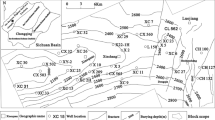Abstract
Predicting the fracture porosity of tight fracture reservoirs represents a difficult problem for log interpretation, although studying conventional log responses of tight fracture reservoirs provides helpful insights. Comparisons and analyses of the log response characteristics of the natural fracture zone of a tight reservoir are performed, and the results indicate that the acoustic (AC) and density (DEN) data are highly sensitive to fractures. First, the log response of the AC and DEN data are sensitive to tight fracture reservoirs, and differences in the AC and DEN log responses are obvious. Second, based on these differences, a model for calculating the fracture porosity is constructed, and an improved Willie difference method for the AC and DEN responses is proposed to calculate the fracture porosity. Finally, we apply the methodology to a case study of a tight reservoir in the Sichuan Basin, China, and then calculate the AC–DEN correlation coefficient and fracture porosity. The calculated fracture porosity is consistent with the fracture porosity from the full borehole micro-resistivity imaging results and core porosity. The results indicate that the method is applicable for predicting the porosity of fractures.
Similar content being viewed by others
References
Karl-Heinz, F.; James, C.M.: Fracture shale gas reservoirs performance study—an offset well interference field test. J. Pet. Technol. 21, 291–300 (1984). doi:10.2118/11224-PA
Curtis, J.B.: Fractured shale-gas systems. AAPG Bull. 86, 1921–1938 (2002). doi:10.1306/61EEDDBE-173E-11D7-8645000102C1865D
Gale, J.F.W.; Laubach, S.E.; Olson, J.E.; Eichhubl, P.; Fall, A.: Natural fractures in shale: a review and new observations. AAPG Bull. 98, 2165–2216 (2014). doi:10.1306/08121413151
Laubach, S.E.: Practical approaches to identifying sealed and open fractures. AAPG Bull. 87, 561–579 (2003). doi:10.1306/11060201106
Sibbit, A.M.; Faivre, O.: The dual laterolog response in fractured rocks. In: SPWLA 26th Annual Logging Symposium, Dallas, Texas (1985). http://dx.doi.org/SPWLA-1985-T.
Philippe, A.P.; Roger, N.A.: In situ measurements of electrical resistivity, formation anisotropy, and tectonic context. In: SPWLA 31st Annual Logging Symposium, Lafayette, Louisiana (1990). http://dx.doi.org/SPWLA-1990-M.
Li, S.J.; Xiao, C.W.; Wang, H.M.: Mathematical model of dual laterolog response to fracture and quantitative interpretation of fracture porosity. ACTA Geophys. Sin. 39, 845–852 (1996). (in Chinese)
Li, S.J.; Wang, H.M.; Xiao, C.W.: Quantitative interpretation of fracture porosity in carbonates. Well Logging Technol. 21, 205–214 (1997). (in Chinese)
Li, S.J.: Inverting fracture porosity and dip of limestone fractured reservoir using 3D FEM. Well Logging Technol. 22, 412–415 (1998). (in Chinese)
Deng, S.G.; Fan, Y.R.; Zhou, C.C.: Fast computing methods for dual laterolog response of fracture of rigid sandstone reservoir. J. Univ. Pet. 29, 31–34 (2005). doi:10.3321/j.issn:1000-5870.2005.03.007
Deng, S.G.; Wang, X.C.; Zou, D.J.; Fan, Y.R.; Yang, Z.: Interpreting dual laterolog fracture data in fractured carbonate formation. J. Earth Sci. 17, 168–172 (2006). doi:10.1016/S1002-0705(06)60024-1
Zhu, D. W.: Developmental characteristics, major regulating factors and distribution prediction of fractures in shale of upper Triassic Yangchang formation in Yangchang oil-gas field: M.S. Thesis, China University of Geosciences (2013) (in Chinese)
Xu, J.L.; Zhang, B.Y.; Qin, Y.X.; Cao, G.W.; Zhang, H.: Method for calculating the fracture porosity of tight-fracture reservoirs. Geophysics 81, IM57–IM70 (2016). doi:10.1190/GEO2015-0434.1
Zeng, L.B.; Qi, J.F.; Wang, Y.G.: Origin type of tectonic fractures and geological conditions in low-permeability reservoirs. Acta Geol. Sin. 28, 52–56 (2007). doi:10.3321/j.issn:0253-2697.2007.04.010. (in Chinese)
Wang, C. M.; Huang, S. J.; Sun, Z. L.; Hu, Z. W.; Huang, K. K.; Dong, H. P.: Characteristics and origin of fractures in tight sandstone reservoirs of the Xujiahe Formation in the western Sichuan depression: A case study in the Xiaoquan–Xinchang–Hexingchang area. Nat. Gas (Industry) (2011). doi:10.3787/j.issn.1000-0976.2011.08.010
Ma, X.; Hao, R.; Lai, X.; Zhang, Y.; Ma, Z.; He, M.; Xiao, Y.; Bi, M.; Ma, X.: Field test of volume fracturing for horizontal wells in Sulige tight sandstone gas reservoirs, NW China. Pet. Explor. Dev. 41, 810–816 (2014). doi:10.1016/S1876-3804(14)60098-7
Liu, X.G.; Zhang, X.: Methods of estimating fracture parameters by logging. Nat. Gas Ind. 23, 31–35 (2003). doi:10.3321/j.issn:1000-0976.2003.04.009. (in Chinese)
Zhang, J.Y.; Sun, J.M.: Log evaluation on shale hydrocarbon reservoir. Well Logging Technol. 36, 146–153 (2012). doi:10.3969/j.issn.1004-1338.2012.02.008. (in Chinese)
Author information
Authors and Affiliations
Corresponding author
Rights and permissions
About this article
Cite this article
Xu, J., Zhang, B. & Xu, L. Predicting the Porosity of Natural Fractures in Tight Reservoirs. Arab J Sci Eng 43, 311–319 (2018). https://doi.org/10.1007/s13369-017-2780-z
Received:
Accepted:
Published:
Issue Date:
DOI: https://doi.org/10.1007/s13369-017-2780-z




